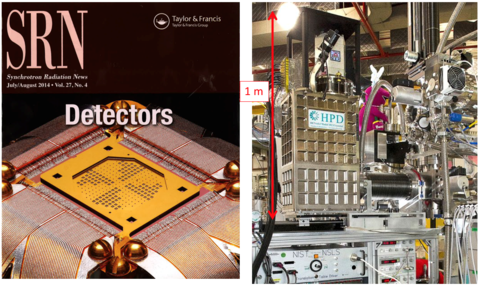Soft X-ray Absorption and Emission Spectroscopy (µCAL)

Left: Cover of the July/August 2014 issue of Synchrotron Radiation News showing an array of NIST's superconducting x-ray sensors installed at the National Synchrotron Light Source. Right: NIST x-ray spectrometer installed at beamline U71 of the National Synchrotron Light Source, Brookhaven National Laboratory. The spectrometer contains 240 x-ray sensors and demonstrates NIST's ability to develop and deliver complete measurement systems.
The Soft X-ray Absorption and Emission Spectrometer uses an array of Transition Edge Sensors, superconducting thin films that are biased into their superconducting-to-normal-metal transitions, to measure photon emissions resulting from the filling of core holes with outer shell electrons. At this condition, photons striking the detector cause minute elevations in temperature, causing the bimetal junction to cross the transition. The change in resistance is monitored by a multistage superconducting quantum interference device (SQUID) amplifier. The resulting voltage pulses provide measurements of individual photon energies. The state of the art microcalorimeter detector, for which the instrument derives its acronym, can achieve orders of magnitude higher efficiency in photon detection over traditional wavelength dispersion based detectors. As a result, the spectrometer excels for low photon intensity measurements common in the measurement of, for example, deeply buried layers or insulators. The primary data from this measurement is also a key factor in accurate modelling of the background in Fluorescence Yield NEXAFS, and as such serves as a natural complement to the NEXAFS spectrometer. In fact, µCAL measurements are sensitive to occupied electronic states (HOMO) which again can be combined with the LUMO data from NEXAFS to provide a direct measure of the band gap.
The microcalorimeter detector for applications in soft X-ray emission spectroscopy is a product of a longstanding collaboration between the NIST Synchrotron Science Group and the NIST Quantum Sensing Group. In the soft X-ray energy range of SST-I, the detector has a resolution of 1 eV. two types of TES pixels, designed for energies below 10 keV (FWHM of 5.9 keV) and below 2 keV (FWHM of 1.0 eV). The detector has 256 pixels over an area of 10 mm2, with a refresh rate of 25 kHz.
Specifications/Capabilities
Beam energy: 0.1 keV to 2.2 keV (SST-I Beamline)
Spot size:
Sample Requirements:
Usage Information
Operating Schedule
The µCAL is currently in commissioning, and is anticipated to be available for general users in 2019.
Access Information
All users are encouraged to discuss potential experiments with the relevant instrument scientist prior to applying for access. After commissioning is complete, access to µCAL will be granted based on merit of the proposed experiment through one of two mechanisms:
1) General users may apply for time through the general user program at NSLS-II. Qualifications, proposal templates, and guidelines are available at https://www.bnl.gov/ps/userguide/.
2) For NIST staff only: NIST projects may request access for experiments by contacting the instrument scientists listed here. Requests are collected and reviewed by the NIST BNL allocation committee and granted time based on merit and fit to the NIST mission. For more information, contact an instrument scientist listed here.

